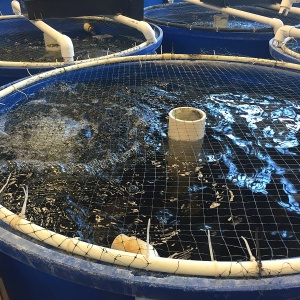
Aquaculture generally supplements wild fisheries rather than replacing them, according to this paper, which used models based on historical data.
The figure below shows the weight of fisheries captures and aquaculture production between 1970 and 2014.
 Image: Figure 1, Longo et al. Total fisheries captures and aquaculture production (excluding aquatic plants) from 1970 to 2014.
Image: Figure 1, Longo et al. Total fisheries captures and aquaculture production (excluding aquatic plants) from 1970 to 2014.
The authors developed a set of regression models based on fisheries captures, aquaculture production, fish consumption, fish exports, gross domestic product, urbanisation, ratio of working-age population to non-working-age population, and country population. The aim of the models was to test whether aquaculture suppresses captures from fisheries once the other factors in the list are accounted for.
The statistical analysis tested two hypotheses: that aquaculture fully displaces capture fishing, or that aquaculture does not influence capture fishing. In the first case, the coefficient for aquaculture production per capita (when predicting fisheries captures per capita) would be -1; in the second case, the coefficient would be 0.
In one out of nine models, significant suppression of fisheries capture was associated with aquaculture production in nations over time. In the remaining eight models, aquaculture production does not significantly suppress fisheries captures.
The authors conclude “Although current aquaculture technologies may have the potential to displace fisheries captures, it appears that production has been structured more toward overall expansion rather than environmental conservation.”
It is not clear from the paper whether fisheries captures would have been even higher in the absence of aquaculture than they are today.
Abstract
In modern aquaculture, animal‐production technology is used to increase aquatic food sources. Such controlled rearing of seafood can, in principle, shift the pressure off wild stocks and aquatic ecosystems by reducing fishing activities, which may advance marine conservation goals. We examined resource displacement—the reduced consumption of a resource due to its replacement with a more environmentally benign substitute—in fisheries. We employed panel regression techniques in an analysis of time‐series data from 1970 through 2014 to assess the extent to which aquaculture production displaced fisheries captures for all nations for which data were available. We estimated 9 models to assess whether aquaculture production suppresses captures once other factors related to demand have been controlled for. Only 1 model predicted significant suppression of fisheries captures associated with aquaculture systems within nations over time. These results suggest that global aquaculture production does not substantially displace fisheries capture; instead, aquaculture production largely supplements fisheries capture.
Reference
Longo, S.B., Clark, B., York, R. and Jorgenson, A.K., 2019. Aquaculture and the displacement of fisheries captures. Conservation Biology, Early View.
Read the full paper here. See also the Foodsource resource How do food systems affect fish stocks and marine habitats?







Post a new comment »